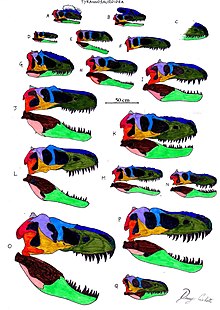Yutyrannus
| Yutyrannus | ||||||||||||
|---|---|---|---|---|---|---|---|---|---|---|---|---|

Live reconstruction of Yutyrannus |
||||||||||||
| Temporal occurrence | ||||||||||||
| Lower Cretaceous ( Barremium to Lower Aptian ) | ||||||||||||
| 130.7 to 123 million years | ||||||||||||
| Locations | ||||||||||||
| Systematics | ||||||||||||
|
||||||||||||
| Scientific name | ||||||||||||
| Yutyrannus | ||||||||||||
| Xu et al. , 2012 | ||||||||||||
| Art | ||||||||||||
|
Yutyrannus is a genus of carnivorous theropod dinosaur from the group of the Tyrannosauroidea . The only known representative of the genus so far is the Yutyrannus huali from the Lower Cretaceous of China, first described in April 2012. The first find consists of three almost completely fossilized skeletons, which come from the Yixian Formation ( Barremium to early Aptian ) in the Chinese province of Liaoning andcan be assignedto two ontogenetic stages.
This dinosaur reached a body length of about nine meters and an estimated weight of about 1,400 kilograms. This makes it the largest feathered dinosaur known to date .
features
Yutyrannus huali was an approx. 9 meter long representative of the Tyrannosauroidea and is anatomically close to the origin of this group. The thighbone of the holotype specimen (specimen number ZCDM V5000) is 85 centimeters long, which is longer than that of some known large tyrannosauroids of the late Cretaceous, such as Dryptosaurus with a thigh bone length of 77 centimeters or Appalachiosaurus with about 79 centimeters. The weight of the ZCDM V5000 is estimated to be more than 1400 kilograms, the two smaller and probably much younger paratype specimens are estimated to weigh around 500 to 600 kilograms. The body length of the largest specimen is estimated to be around nine meters.
The skull of Yutyrannus huali differs from other tyrannosauroids by a wrinkled and hollow bone crest formed by the paired nasal bone and the premaxillary , as well as by other skull features. The axial skeleton , the shoulder girdle and the pelvis also have specific features.
In all three specimens, remains of the body covering are preserved, which consist of clearly recognizable filaments . In the case of the holotype specimen, where they are preserved in the area of the caudal spine, these are at least 15 centimeters long. In the two paratypes, these structures, which are interpreted as filamentous feathers , occur in different parts of the body and sometimes measure more than 20 centimeters. Xu and colleagues (2012) assume on the basis of this discovery that Yutyrannus huali had a plumage made of proto feathers similar to those of Dilong and other dinosaurs . This makes Yutyrannus huali the largest known feathered dinosaur ; it was about 60 times heavier than Sinocalliopteryx and 40 times heavier than Beipiaosaurus .
Site and fossils
Yutyrannus huali was described on the basis of three almost complete skeletons from the Yixian Formation near Beipiao in the west of Liaoning Province in the People's Republic of China . The holotype -Exemplar ZCDM V5000 and one of the para-type -Exemplare (ZCDM V5001) are in dinosaur Museum in Zhucheng in the province of Shandong stored while the second para-type copy ELDM V1001 in dinosaur Museum erenhot in Inner Mongolia archived is. All three skeletons are almost complete, the ELDM V1001 lacks the tail.
Taxonomy and systematics
The genus Yutyrannus and the type species Yutyrannus huali contained in it were first described by a Chinese research group in the scientific journal Nature in April 2012 . The genus was named on the basis of the Mandarin word “yu” for “feathers” and the Latin “tyrannus” for “king” or “tyrant”. The species name "huali" also comes from Mandarin and means "beautiful".
The descriptors Xu and colleagues (2012) classify Yutyrannus as a basal (original) representative of the Tyrannosauroidea . Thus, this genus is classified in the ancestral series of Tyrannosaurus and Dryptosaurus . He is considered Schwestertaxon a clade , all abgeleiteteren (advanced) Representatives of Tyrannosauroidea contains, so the also from the Lower Cretaceous coming eotyrannus , xiongguanlong , said Tyrannosauridae including Tyrannosaurus and Dryptosaurus .
literature
- Xing Xu , Kebai Wang, Ke Zhang, Qingyu Ma, Lida Xing, Corwin Sullivan, Dongyu Hu, Shuqing Cheng, Shuo Wang: A gigantic feathered dinosaur from the Lower Cretaceous of China. In: Nature . Vol. 484, No. 7392, 2012, pp. 92–95, doi : 10.1038 / nature10906 , (PDF; 1.8 MB).
Web links
- Brandom Keim: Giant Feathered Tyrannosaur Found in China . Wired Science April 4, 2012.
supporting documents
- ↑ Zhonghe Zhou , Paul M. Barrett , Jason Hilton: An exceptionally preserved Lower Cretaceous ecosystem. In: Nature . Vol. 421, No. 6925, 2003, pp. 807-814, doi : 10.1038 / nature01420 .
- ↑ a b c d e Xing Xu , Kebai Wang, Ke Zhang, Qingyu Ma, Lida Xing, Corwin Sullivan, Dongyu Hu, Shuqing Cheng, Shuo Wang: A gigantic feathered dinosaur from the Lower Cretaceous of China. ( Memento of April 17, 2012 in the Internet Archive ) In: Nature. Vol. 484, No. 7392, 2012, pp. 92–95, doi : 10.1038 / nature10906 , (PDF; 1.8 MB).
- ↑ a b Xing Xu, Kebai Wang, Ke Zhang, Qingyu Ma, Lida Xing, Corwin Sullivan, Dongyu Hu, Shuqing Cheng, Shuo Wang: A gigantic feathered dinosaur from the Lower Cretaceous of China. Supplementary information . Vol. 484, No. 7392, 2012, doi : 10.1038 / nature10906 , (PDF; 961 kB).

